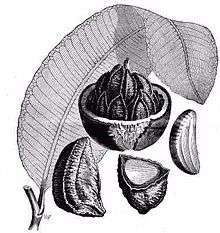Osteocephalus castaneicola
Osteocephalus castaneicola is a species of frog in the family Hylidae. It is found in lowland Amazonia of northern Bolivia, adjacent southeastern Peru, and western Brazil (Acre, south-central Amazonas, and Rondônia).[3][4] It breeds in water-filled fruit capsules of the Brazil nut, a characteristic also alluded to in its specific name castaneicola derived from the Latin castanea (horse chestnut, Aesculus), the root of the vernacular name castaña for the Brazil nut, together with the Latin colō meaning "to inhabit".[2]
| Osteocephalus castaneicola | |
|---|---|
| Scientific classification | |
| Kingdom: | Animalia |
| Phylum: | Chordata |
| Class: | Amphibia |
| Order: | Anura |
| Family: | Hylidae |
| Genus: | Osteocephalus |
| Species: | O. castaneicola |
| Binomial name | |
| Osteocephalus castaneicola Moravec, Aparicio, Guerrero-Reinhard, Calderón, Jungfer, and Gvoždík, 2009[2] | |
Description
Adult males measure 48–51 mm (1.9–2.0 in) and adult females 48–63 mm (1.9–2.5 in) in snout–vent length. The snout is rounded in dorsal view and rounded, slightly inclined posteroventrally in lateral profile. The canthus rostralis is distinct. The tympanum is large, oval to round in shape. The supratympanic fold is conspicuous and covers the upper edge of the tympanum. The fingers have basal webbing whereas the toes are three quarters webbed. The dorsum is tan to pale brown to purple brown. and has some narrow irregular, dark brown markings. The upper lip has a narrow pale supralabial line that expands into a subocular spot. The flanks are uniformly pale. The throat and belly are creamy white. The thighs are ventrally fleshy pink. The iris is bicoloured: golden above, bronze below, and with a dark horizontal stripe and reticulate or radiating lines. Vocal sac in males is indistinct.[2]
The largest tadpoles are 33–35 mm (1.3–1.4 in) in total length.[2]

Reproduction
Reproduction takes place in water-filled Brazil nut fruit capsules, or seldom, in water-filled palm bracts lying on the forest floor. A single capsule can contain tens of tadpoles. These capsules are opened and left on the forest floor by agoutis or by local people.[1][2] Osteocephalus castaneicola is the first hylid frog known to use this reproductive strategy, but similar behavior has been reported for two dendrobatids, Adelphobates castaneoticus and Adelphobates quinquevittatus, and for one bufonid, Rhinella castaneotica. The tadpoles are oophagous, i.e., they may consume conspecific eggs.[2]
Habitat and conservation
Osteocephalus castaneicola occurs in both terra firme (unflooded) and floodplain rainforests at elevations of 81–400 m (266–1,312 ft) above sea level.[1][4] Individuals have typically been observed sitting on vegetation 0.5–2 m (2–7 ft) above the ground.[1][2][4]
This species is locally threatened by habitat loss caused by agricultural activities (including habitat conversion for cattle ranching) and by illegal gold mining. It occurs in the Manu National Park and Los Amigos Conservation Concession in Peru,[1] and in the Cuniã Ecological Station and Jamari National Forest in Brazil.[4]
References
- IUCN SSC Amphibian Specialist Group (2013). "Osteocephalus castaneicola". IUCN Red List of Threatened Species. 2013: e.T190998A1966043. doi:10.2305/IUCN.UK.2013-1.RLTS.T190998A1966043.en.
- Moravec, J.; Aparicio, J.; Guerrero-Reinhard, M.; Calderón, G.; Jungfer, K.-H. & Gvoždík, V. (2009). "A new species of Osteocephalus (Anura: Hylidae) from Amazonian Bolivia: first evidence of tree frog breeding in fruit capsules of the Brazil nut tree". Zootaxa. 2215: 37–54.
- Frost, Darrel R. (2018). "Osteocephalus castaneicola Moravec, Aparicio, Guerrero-Reinhard, Calderón, Jungfer, and Gvoždík, 2009". Amphibian Species of the World: an Online Reference. Version 6.0. American Museum of Natural History. Retrieved 24 May 2018.
- Meneghelli, Diego & Neto, Omar Machado Entiauspe (2014). "New records from Brazil and first record from the state of Rondônia of Osteocephalus castaneicola Moravec, Aparicio, Guerrero-Reinhard, Calderón, Jungfer & Gvoždík, 2009 (Anura: Hylidae) with an update on its geographical distribution" (PDF). Check List. 10 (4): 957–959. doi:10.15560/10.4.957.
